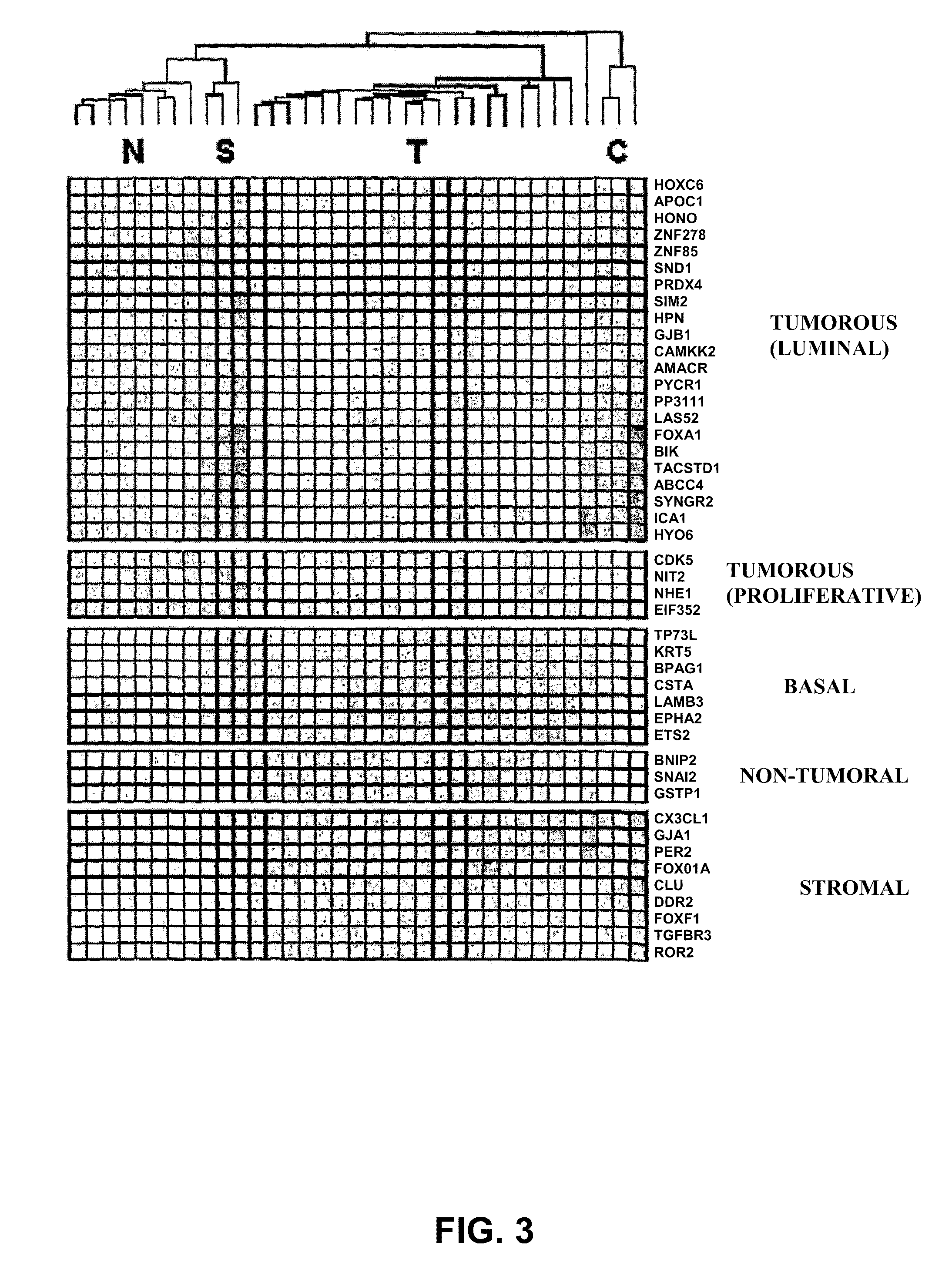Method for the Molecular Diagnosis of Prostate Cancer and Kit for Implementing Same
a prostate cancer and molecular diagnosis technology, applied in the field of biotechnology, can solve problems such as not giving fully consistent results
- Summary
- Abstract
- Description
- Claims
- Application Information
AI Technical Summary
Problems solved by technology
Method used
Image
Examples
example 1
Identification of the Genes Associated with a Cluster Identifying a Prostate Cancer Tumor Pattern
[0074]For the realization of the present invention, a series of 31 human prostate samples were analyzed by hybridization on Affymetrix Human Genome Focus arrays (FIG. 1):
[0075]I. 20 samples enriched with carcinomatous epithelium.
[0076]II. 7 samples enriched with normal epithelium (<1% of cancer cells).
[0077]III. 1 sample comprising a group of 5 normal samples (POOL N).
[0078]IV. 3 samples consisting exclusively of stromal tissue.
[0079]The collected tissues were embedded in OCT, frozen in isopentane, and stored at −80° C. The samples were assessed histologically and selected for analysis in accordance with the following criteria: (a) minimum 90% of pure normal or carcinomatous epithelium in the normal and carcinomatous samples, respectively; (b) absence or minimal presence of foci of inflammation or atrophy. All the samples except three (one normal and two carcinomatous) come from the peri...
example 2
Validation of the Genes Identified as Most Relevant in the Microarray Hybridization Experiments by Means of Real-Time RT-PCR Using the TaqMan LDA Format
[0090]This was done by performing real-time RT-PCR on the genes of greatest interest biologically and as markers from the complete panel of 318 genes identified previously, using both non-microdissected samples and samples laser-microdissected using the PALM instrument. The object of the RT-PCR analysis is to determine the expression levels of these genes in a diagnostic chip-type format, which is smaller and more akin to clinical practice.
[0091]Real-time RT-PCR was carried out for each replica of prostate tissue (in triplicate) or of microdissected samples (in quadruplicate), whether of carcinomatous or normal tissue. Thus, 1 ng of starting total RNA was used for the synthesis of cDNA using the reverse transcriptase Superscript II (Invitrogen) and random hexamers at 42° C. for 50 min, followed by treatment with RNase at 37° C. for 2...
example 3
Immunohistochemical Technique Used on Tissue Microarrays
[0102]The tissue microarrays were constructed using a Beecher instrument (Beecher Instruments) and a 1 mm-diameter needle. Three different microarrays were constructed, containing selected zones of samples of normal prostate, carcinomatous prostate, and PIN tissue, all previously embedded in paraffin. Blocks of lung tissue previously stained with three different colors and placed in different zones of the microarray were used as orientation markers for the samples within the arrays. Complete sections of the microarrays were taken and stained with hematoxylin-eosin to confirm quality. 2 μm thick sections were taken and mounted on xylene-coated glass slides (Dako, Carpinteria, Calif.) for the immunohistochemical stainings. These were done with the Techmate 500 system (Dako), using the Envision system (Dako) for the detection. Briefly, the sections were deparaffinized and rehydrated in graded alcohol series and water. For the dete...
PUM
 Login to View More
Login to View More Abstract
Description
Claims
Application Information
 Login to View More
Login to View More - R&D
- Intellectual Property
- Life Sciences
- Materials
- Tech Scout
- Unparalleled Data Quality
- Higher Quality Content
- 60% Fewer Hallucinations
Browse by: Latest US Patents, China's latest patents, Technical Efficacy Thesaurus, Application Domain, Technology Topic, Popular Technical Reports.
© 2025 PatSnap. All rights reserved.Legal|Privacy policy|Modern Slavery Act Transparency Statement|Sitemap|About US| Contact US: help@patsnap.com



